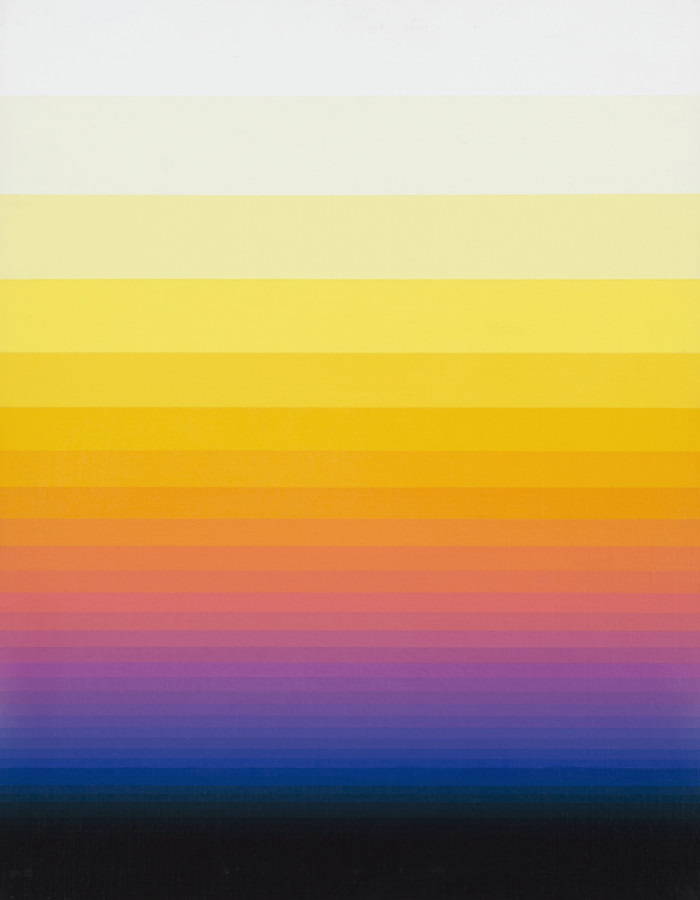Norman Zammitt: 1966-1977
@ ANDREW RAFACZ
835 W Washington Blvd, Chicago, IL 60607
Opening Saturday, January 26th, from 5PM - 8PM
On view through Saturday, March 9th
ANDREW RAFACZ begins 2019 with Norman Zammitt: 1966-1977, a solo presentation of sculptural works and painting by the Light and Space pioneer Norman Zammitt. The exhibition continues through Saturday, March 9, 2019.
Norman Zammitt: 1966-1977 aims to capture the important transition the artist made from his sculptural works of the second half of the sixties to the paintings of the seventies, while showcasing newly acquired works in both mediums.
In the early sixties, Norman Zammitt was teaching at the University of New Mexico. While working on his early figural paintings, he observed the mixture of colors on his glass palette. Influenced by New Mexico’s light, color, and space, he became more interested in what was happening on his palette than on the canvas. He transferred his painting process to sheets of glass, followed by acrylic plastic, leading to the start of his transparent sculptures, the first of that genre shown in Los Angeles and New York. Eventually Zammitt laminated thicker sheets to create a solid piece, overlapping patterned images of transparent pigment in the embedded, translucent image, creating a layered three-dimensionality. The results are inherent in Honeycomb IV (1966), presented here for the first time.
Following, the acrylic resin works from the mid-sixties, Zammitt pushed the painterly possibilities of the sculptural object further with his ‘poles.’ These sculptures, roughly seven to ten feet in length and one to 2 inches square, round, octagonal, hexagonal or spindled, were constructed with solid color acrylics in an order of color frequencies, then laminated and polished. The final object combined the transparent, translucent and opaque in a combination varying from matte to high gloss. These banded works in unique color combinations and indebted to his observations of the natural world as well as his own early years growing up on the Caughnawaga reservation, undoubtedly paved the way for his return to painting in the seventies.
The sculptures, suspending color in space, led the artist back to painting on canvas entirely in the abstract in pursuit of understanding and expressing color itself. Zammitt had a spiritual connection to color that outstripped any basic aesthetic appreciation. He sought to parallel the abstraction of light in paint, to correlate palette and sky. He found that none of the different theories of color were quite related to nature, so he began putting color into what he felt was their natural sequence. This exhibition presents a selection of his smaller paintings from 1975-1977, some as studies for his larger canvases and others that are completely unique, and at times more directly compositional and related to his previous sculptural work.
NORMAN ZAMMITT (Canadian, b. 1931 – 2007) lived and worked in Pasadena, California. Zammitt was of First Nations and Sicilian descent. Following life on the Caughnawaga Reservation outside of Montreal and in Buffalo New York, he moved with his family to California in 1945. He studied at Pasadena City College and went on to earn his MFA at Otis Art Institute in 1961, where he created collages and abstract paintings inspired by the landscape. In 1964 Zammitt turned from oil paint to acrylic plastic resin, producing box-like sculptures that explored color and transparency. By the early 1970s, he returned to painting, continuing his investigations of color relationships through precisely rendered striped paintings. Zammitt’s mathematical color combinations produce the illusion of deep dimensionality and dramatic optic effects. His large painting North Wall(1977) was included in the Getty’s Pacific Standard Time exhibition in 2011. His work is included in the collections of the Museum of Modern Art (New York, NY), Los Angeles County Museum of Art (Los Angeles, CA), San Francisco Museum of Art (San Francisco, CA), Seattle Museum of Art (Seattle, WA), Hirshhorn Museum (Washington D.C.), Norton Simon Museum (Pasadena, CA) and the Rowland Institute of Science (Cambridge, MA), among many others. He is also included in numerous private collections around the world.
Official Website
More events on this date
Tags: 1966-1977, andrew rafacz, Chicago, near west side, Norman Zammitt

« previous event
next event »